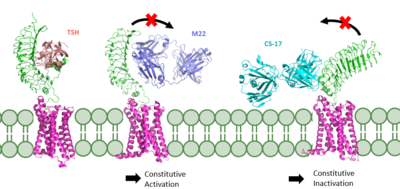Sandbox Reserved 1775
From Proteopedia
(Difference between revisions)
| Line 8: | Line 8: | ||
== Binding of Thyroid Stimulating Hormone to TSHR== | == Binding of Thyroid Stimulating Hormone to TSHR== | ||
| - | The Thyroid Stimulating Hormone <scene name='95/952703/Tsh-ecd/3'>binds to the extracellular domain</scene> by complementary shape. The ECD and is curved and compliments the curvature of TSH similar to how a baseball fits into a glove. There are also several key ionic interactions between the TSH and TSHR. The key ionic interactions occurs in the <scene name='95/952703/Seatbelt/3'>Seat Belt region of TSH</scene> which is highlighted in yellow. The seatbelt region is located in the beta subunit of the TSH. <scene name='95/952703/Tsh-tshr_itxn-3/ | + | The Thyroid Stimulating Hormone <scene name='95/952703/Tsh-ecd/3'>binds to the extracellular domain</scene> by complementary shape. The ECD and is curved and compliments the curvature of TSH similar to how a baseball fits into a glove. There are also several key ionic interactions between the TSH and TSHR. The key ionic interactions occurs in the <scene name='95/952703/Seatbelt/3'>Seat Belt region of TSH</scene> which is highlighted in yellow. The seatbelt region is located in the beta subunit of the TSH. <scene name='95/952703/Tsh-tshr_itxn-3/4'>The first ionic interaction</scene> is Glu118 from TSH and Lys58 from the ECD.<scene name='95/952703/Tsh-tshr_itxn-2/3'>The second interaction</scene> is between Asp111 from the TSH and Lys209 from the ECD. These interactions form salt bridges between the ECD and the TSH which allows for specificity of binding for TSH to TSHR. |
| - | Other key interactions that allow for specificity of binding are <scene name='95/952703/Tsh-tshr_itxn-4/ | + | Other key interactions that allow for specificity of binding are <scene name='95/952703/Tsh-tshr_itxn-4/3'>polar and nonpolar interactions</scene> between the helix 1. Helix 1 contains several polar residues that interact with surrounding nonpolar residues like Leu62, Arg54, and Phe17. These interactions increase the activation potency and helps activate the push and pull mechanism of the hinge region. |
== Blocking TSHR in Active/Inactive States == | == Blocking TSHR in Active/Inactive States == | ||
Revision as of 23:02, 2 April 2023
| This Sandbox is Reserved from February 27 through August 31, 2023 for use in the course CH462 Biochemistry II taught by R. Jeremy Johnson at the Butler University, Indianapolis, USA. This reservation includes Sandbox Reserved 1765 through Sandbox Reserved 1795. |
To get started:
More help: Help:Editing |
Your Heading Here (maybe something like 'Structure')
| |||||||||||

